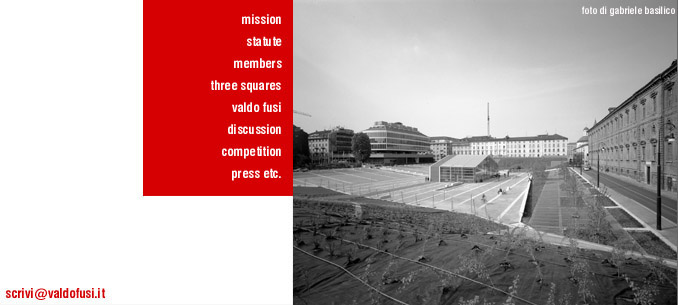
|
piazzale valdo fusi the area which is known today as piazza valdo fusi was generally known in the middle of the xviii c. as "crucifix block" - a rectangular square owned by the catholic church. after the expropriation of the church's properties by the french government at the beginning of the xic c., the area was transferred to the state. in 1868 the site was finally built up and completely transformed into a closed block. it became the site of the city's royal industrial museum, the history of which is linked with the one of turin royal school of engineers and the polytechnic. the latter was located within the aforementioned block from 1910 to 1943, when the whole area was destroyed during wwii bombings. some of the surrounding buildings were also compromised. the nearby xvi c. palace designed by morozzo della rocca and seat of the local chamber of commerce since 1871, was completely demolished. buildings on the other sides of the square suffered only minor damages: the san sebastian block to the north (with the trinity costa carru palace, and the xvii century "collegio delle province"); the san vittore block to the south (with late xix c. houses and the hospital s.giovanni battista, currently natural sciences museum, designed by castellamonte in 1680) were intact. after wwii the block corresponding to the piazzale valdo fusi remained un-built, while reconstruction proceeded step by step on the neighboring sites. between 1952 and 1957 the stock exchange building was realized in one corner of the square based on a design by roberto gabetti, aimaro isola, giorgio and giuseppe reineri. a competition was then held for the rebuilding the chamber of commerce headquarters. the winning entry, due to architect carlo mollino (with carlo gressi and alberto galardi), was realized in 1969. in 1964 finnish architect alvar aalto (with his then apprentice leonardo mosso) were commissioned a design on the square by the late fiat chairman giovanni agnelli. the project proposes a new multi-functional center with hotels, offices and convention spaces. the offices are positioned alongside the streets, while the hotel has it 150 rooms facing a large garden. the project is based on the assumption that the whole area will become completely pedestrian, with an underground two-floor parking lot. the congress center is placed far from the hotel, at the opposite corner near the cavour street. the project, however, will never be realized. in 1986 the square, then renamed valdo fusi, is used for public parking at ground level. in 1990 the chamber of commerce promotes a study on the site. different working groups analyze analogues projects world-wide and submit their proposals. while rather different, all of them focus on large pedestrian areas and possible connections with the neighboring green plazas. in 1996-97 the turin public transport company (a.t.m.) proposes a design for a two-floor underground parking. apart from the air inlets, the project does not take into account the design of the upper surface of the parking. upon request of the municipality, a competition is therefore called to complete the engineering design with a more architectural solution on the surface. the competition announcement refers to an "environmental re-arrangement project" aimed at the "re-qualification and (..) re-evaluation of the square". the goal is should be creating a green space with few emerging parts. the winning entry is due to architects francesco dolza, massimo crotti, and piero felisio (presented by valentino castellani, major of that time, in the introduction of the exhibition catalogue). in 2004 the underground parking is officially open and in 2005 the emerging parts are completed. piazza carlo emanuele II (piazza carlina) the square between the roads accademia albertina and maria vittoria has the name of duke carlo emanuele ii, son of vittorio amedeo i and cristina of france; however, citizens of turin confidentially call it "carlina". it is approximately 15,000 square meters and was realized during the city's second enlargement at the end of xvii c. based on a design by amedeo di castellamonte. the square has been the site of the wine, wood, coal and hay markets. during the french revolutionary government (1798-1814), a guillotine was erected in it and many death sentences were executed. the monument to count camillo benso di cavour, italy's first prime minister, stands in the middle of the square. this statue, erected in 1873, was realized by giovanni duprè and it initially provoked several polemics because of the underlying allegoric representation (a trembling italy clinging to the count). important buildings and palaces face the square: on the east side, between the streets des ambrosis and maria vittoria, there is the guarene palace, whose façade was designed by baroque master filippo juvarra in 1730. to its right, the so called "albergo di virtu'", a religious charity for the assistance of poor children. to the south side the bergia casern, former college of the provinces, designed by bernardo vittone, as well as the santa croce church designed by filippo juvarra in 1718. finally, to the west side, the palace coardi di capeneto, by architect castellamonte. aiuola balbo the turin ramparts' demolition between 1834 and 1837 allowed the realization of a large green system called "giardino dei ripari". the area was later partially built up and subdivided into three green squares: maria teresa, cavour and balbo. in the center of the balbo garden, where a monument of the venetian patriot daniele manin now stands, there was a cafè called "la rotonda", which was the center of turin's outdoor life during the warm season. basic bibliography aavv,
il piazzale valdo fusi a torino - per un progetto di trasformazione,
camera di commercio di torino, torino 1991
|